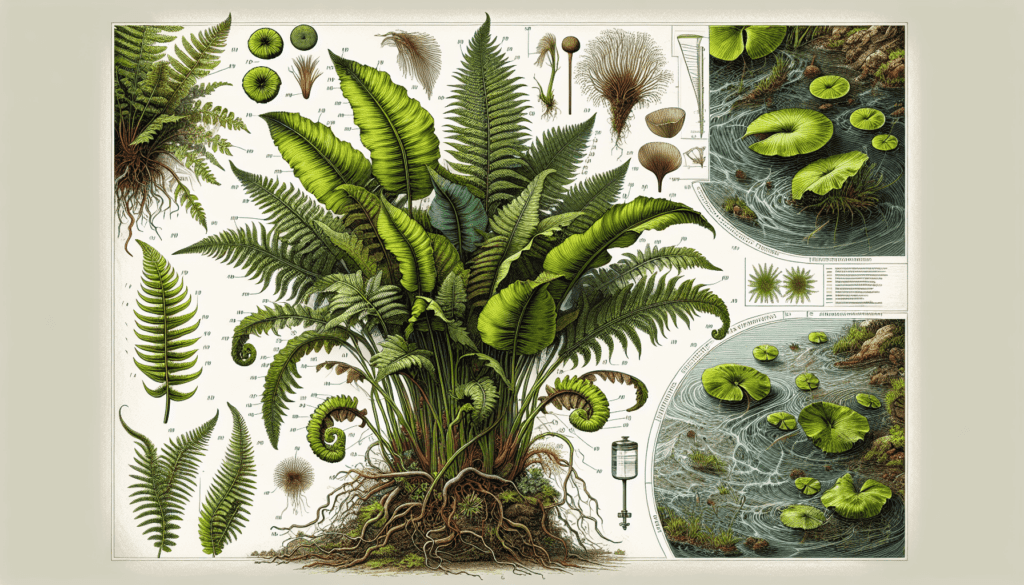Embarking on a botanical exploration, this article acquaints you with the intriguing world of aquatic plants, primarily focusing on the American Water Fern. As a reader, you will develop a profound understanding of its biological classification, its anatomy, and its ecological significance. Notably, the American Water Fern is not just another water-based plant species, but an enigmatic life form with its unique growth patterns and survival mechanisms. This discourse aims to enhance your awareness about this fascinating piece of nature, and significantly broaden your perspective of the under-studied field of water plants.

Understanding American Water Fern
Definition of American Water Fern
American Water Fern, commonly referred to as mosquito fern or water velvet, is a free-floating, aquatic fern that thrives in slow-moving water bodies. Characterized by small, overlapping leaves, you will often see it blanket water surfaces in a lacey, vivid green mat, giving an illusion of a rich, velvety texture.
Scientific name and classification
Scientifically, the American Water Fern is known as Azolla caroliniana. It belongs to the family of Azollaceae, under the genus of Azolla. This plant is classified as a Pteridophyte, a group of mostly aquatic plants commonly known as the ferns and their allies.
Global distribution
The American Water Fern is native to much of North and Central America, including the United States, Mexico, and the Caribbean, and is one of the most common species of its genus. However, it has managed to spread to other parts of the world and can now be found in various regions in Africa, Asia, and Europe.
Adaptive features
American Water Fern has evolved various adaptive features that allow it to thrive in aquatic environments. One of its key adaptations is the presence of minute, overlapping leaves which help float the plant above the water surface, thus enabling photosynthesis. Additionally, this plant can form a symbiotic relationship with nitrogen-fixing cyanobacteria, allowing it to survive in nutrient-poor waters.
Morphology of American Water Fern
Plant structure
The American Water Fern is a petite aquatic plant, typically measuring not more than 1.5 inches in height. Its compact growth habit forms dense mats on water surfaces, held together by a delicate system of hair-like roots below the water.
Leaf structure
The leaves are scale-like and overlap each other, forming fronds that float just above the water surface. These leaves are bilobed, with one lobe floating on the water and the other submerged.
Root structure
This plant comprises a myriad of delicate, hair-like roots that hang below the surface of the water. They do not anchor the plant to the soil but play a crucial role in absorption of nutrients from the water.
Plant reproduction mechanisms
American Water Fern can reproduce both sexually (via spores) and vegetatively, with the latter being the more common method. In vegetative reproduction, the plant merely breaks apart and forms two or more individuals.
Habitat and Ecological role of American Water Fern
Preferred habitat conditions
American Water Fern prefers slow-moving or still waters such as ponds, lakes, or ditches. It ideally thrives in warm, sunlit conditions and is commonly found in regions with a warm-temperate to tropical climate.
Role in the ecosystem
American Water Fern plays a crucial role in the ecosystem. The dense surface mats provide a habitat and food source for various aquatic invertebrates. Meanwhile, the plant’s ability to fix atmospheric nitrogen makes it beneficial for nutrient-poor waters where other plants or algae might not survive.
Interactions with other species
This aquatic fern interacts with a variety of water-dwelling organisms. Many small invertebrates rely on the plant for a habitat and food source. Simultaneously, its symbiotic relationship with nitrogen-fixing cyanobacteria benefits the water body’s biological equilibrium.
Endangered species protection status
American Water Fern is not currently listed as endangered or threatened. However, it is essential to monitor its growth and distribution due to its invasive nature in some regions.
Growth and Development of American Water Fern
Growth Rate
American Water Fern has a fast growth rate and can double its biomass in just a few days under ideal conditions.
Seasonal growth patterns
This plant typically proliferates during the warm seasons and can significantly slow down or even become dormant during colder months, depending on the climate.
Conditions affecting the growth
Various factors such as sunlight, water temperature, nutrient availability, and competition from other species can affect the growth of American Water Fern.

American Water Fern and Water Quality
Importance in water filtration
Given its fast growth and nutrient uptake, American Water Fern can contribute significantly to water filtration. It can remove excess nutrients from the water, helping to maintain water quality.
Role in pollution reduction
This plant’s unique ability to absorb heavy metals from the water it inhabits makes it a potential tool in reducing pollution in water bodies.
Impact on water chemistry
Through nutrient uptake and nitrogen fixation, the American Water Fern can influence the chemistry of the water body it inhabits.
American Water Fern as an Invasive Species
International and domestic regulations
Many regions have implemented regulations to control American Water Fern due to its invasive nature. It is listed as a noxious weed in some regions and countries.
Impact on local ecosystems and biodiversity
While the American Water Fern can benefit aquatic ecosystems, uncontrolled growth can stifle local biodiversity by blocking sunlight and reducing oxygen levels in the water.
Control and management strategies
Strategies to control this plant’s growth include physical removal, use of herbicides, and introduction of biological control agents such as specific weevils.
Use of American Water Fern in Aquaponics
Role in aquaponic systems
In aquaponic systems, the American Water Fern assists in nutrient cycling by absorbing excess nutrients from the water released by fish and other aquatic animals.
Benefits and drawbacks
While American Water Fern can enhance aquaponic systems’ efficiency, its rapid growth can potentially overrun the system if not properly managed.
Tips for successful cultivation
Constant monitoring and control measures can ensure successful cultivation of this plant in aquaponic systems.
Medicinal and Cultural Significance of American Water Fern
Historical uses in traditional medicine
Historically, some cultures have used American Water Fern for medicinal purposes. For example, some Native American tribes reportedly used this plant to treat conditions such as fever and rheumatism.
Modern research into medical properties
Recent research into American Water Fern has revealed potential medicinal properties, including antioxidant and antimicrobial activities. However, more extensive studies are needed to confirm and understand these properties fully.
Role in local cultures and traditions
Apart from medicinal uses, American Water Fern holds cultural significance in some regions. For instance, in certain areas, it is used for religious ceremonies and decorative purposes.
Cultivation and Care for American Water Fern
Requirements for growing American Water Fern
Growing American Water Fern requires a still or slow-moving water body with ample sunlight. While the plant can tolerate various water pH levels, it prefers slightly acidic to neutral conditions.
Common diseases and pests
American Water Fern is relatively resilient and not often susceptible to many diseases or pests. However, rapid changes in environmental conditions can stress the plant and make it more susceptible to disease.
Tips and tricks for healthy plants
Regular monitoring and management can maintain healthy American Water Fern populations. Removing excess plants can prevent overgrowth and maintain the water body’s health.
American Water Fern in Aquariums and Ponds
Role in aquarium and pond ecosystem
American Water Fern can be a beneficial addition to aquariums and ponds. It provides food and habitat to some aquatic species, assists in nutrient cycling, and adds aesthetic value.
Interaction with fish and other aquatic species
In a well-managed ecosystem, American Water Fern can coexist with various fish and other aquatic species. However, overgrowth of the plant can lead to competition for resources.
Care and maintenance in aquariums and ponds
In aquariums and ponds, it’s crucial to manage the plant’s growth to prevent it from overpowering the system. Equally important is maintaining a balance among different species to ensure a healthy, thriving ecosystem.
